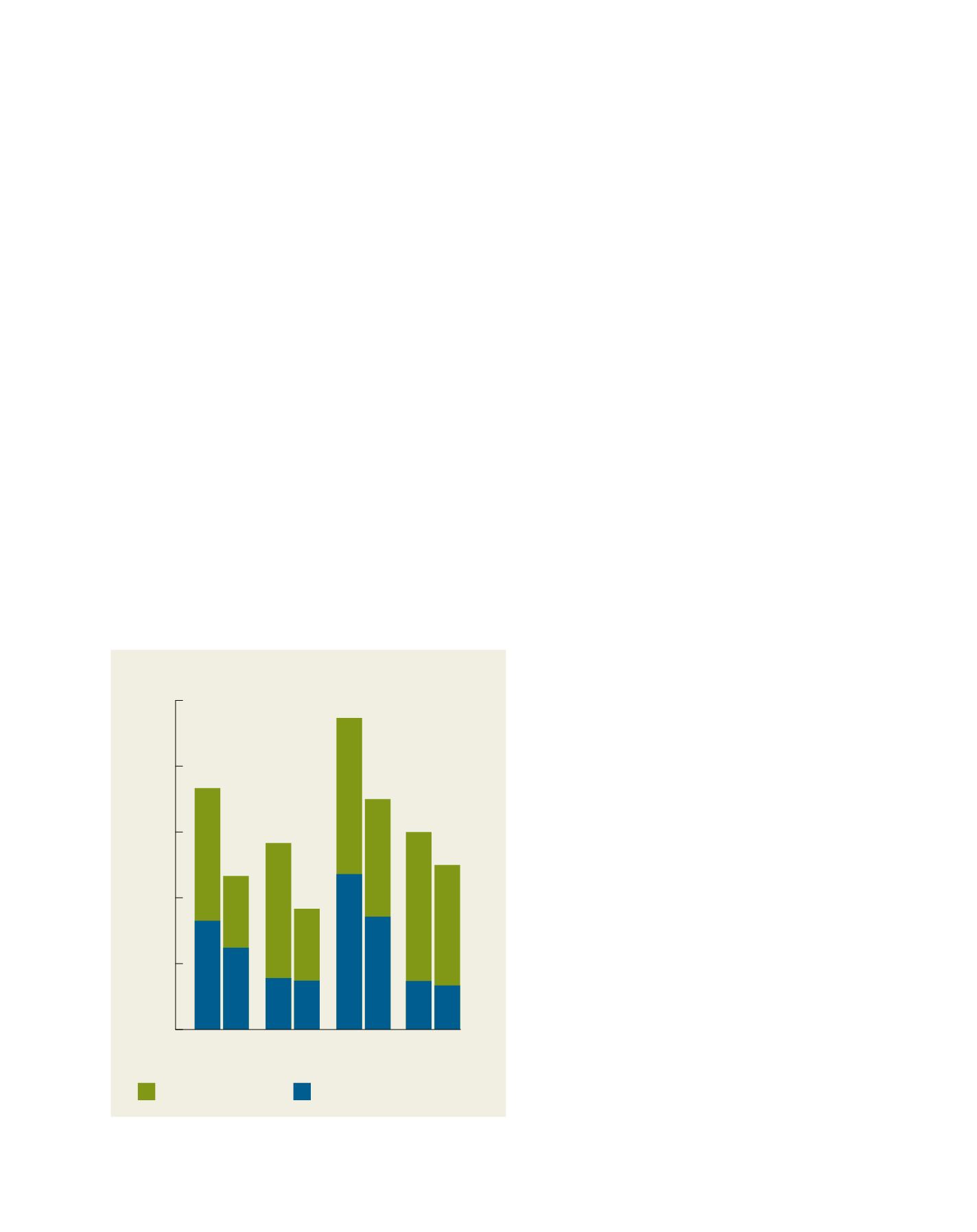

[
] 221
W
ater
C
ooperation
, S
ustainability
and
P
overty
E
radication
(spring) season, mostly to vegetables and flowers. Overall, in the
65 community watersheds, implementing best-bet practices with
better water management resulted in significant yield advantages in
sorghum (35-270 per cent), maize (30-174 per cent), pearl millet
(72-242 per cent), groundnut (28-179 per cent), sole pigeonpea
(97-204 per cent), and intercropped pigeonpea (40-110 per cent).
Integrated watershed management in India, primarily through
water conservation and management compounded with various
in-situ
and
ex-situ
interventions and improved practices, have
shown a significant increase in productivity, cropping intensity
and income while controlling degradation of natural resources. The
increase in cropping intensity, benefit-to-cost ratio and per capita
income ranged between 30-55 per cent, 45-88 per cent and 19-78
per cent respectively in different community watersheds after the
implementation of watershed interventions over the baseline period.
In all these watersheds, the key driver for remarkable change is an
increasing quantity of greenwater and bluewater resources in the
form of soil moisture through groundwater recharge initiatives such
as
ex-situ
and
in-situ
interventions. These interventions have built
resilience during drought years. As evident from the data at Adarsha
watershed in Andhra Pradesh, the share of agricultural income to
total family income remained the same in the 2002 drought year,
whereas non-watershed villages experienced a drastic reduction
in agricultural income from 44 per cent to 12 per cent of family
income. Families in these villages had to migrate to supplement
their livelihoods, whereas in Kothapally, farmers could manage their
livelihoods in the village itself.
The participatory collective action approach adopted for bridg-
ing the yield gaps in the state of Karnataka has demonstrated the
vast potential of dryland agriculture for increasing the
crop yields and incomes of millions of small farmers.
The unique mechanism of scaling-up with comprehen-
sive planning, review and monitoring along with new
institutions like Farm Facilitators, Raitha Samparka
Kendras and supporting policies enabled the consor-
tium to cover 3.73 million hectares of rain-fed area
in the state. Under the Bhoochetana programme,
soil-test-based nutrient management interventions
along with improved seeds, seed treatments and use
of biofertilizers resulted in 35-66 per cent increases
in yield levels of dryland crops during the 2009 rainy
season in different districts. During the 2011 rainy
season with an unfavourable rainfall situation, the
programme resulted in increases of 21-66 per cent
in major crop yields and 23-42 per cent in oilseeds
over farmers’ practice. For the GoK, this translated
to an annual agricultural growth rate of 5.9 per cent
during 2009/10, and 11.6 per cent during 2010/11.
During 2011, 3 million hectares were covered in the
rainy season and economic returns were to the tune
of US$130 million. In spite of an unfavourable rain-
fall situation in the state, farmers harvested increased
crop yields with improved management practices,
contributing to the economy of the state. This has
demonstrated the power of science-led interventions
to achieve sustainability in the management of natural
resources for food security and poverty reduction in
fragile areas.
Achieving food security and resilience
Water scarcity and land degradation are the main
constraints to realizing higher productivity and improv-
ing rural livelihoods in the semi-arid regions. The
integrated community watershed management approach
is a well tested strategy to address the issues of water
and soil degradation along with equity, efficiency and
environment. Scarcity of water and knowledge sharing
through the participatory monitoring of increased
groundwater made farmers more receptive towards
efficient water use technologies such as drips and sprin-
klers, and enabled them to take appropriate decisions
about suitable crops and areas to be planted. The new
common guidelines have provided a framework to bring
people to centre stage in taking decisions to improve
productivity and livelihoods through sustainable use
of natural resources. Within the watersheds, stratified
soil sampling and soil-test-based nutrient management
provides economic solutions to address soil degrada-
tion. Model watersheds and Bhoochetana in India have
demonstrated the role of a science-led approach in
changing farm-based livelihoods. However, policies and
institutional mechanisms played a greater role in opera-
tionalizing the strategy. To achieve the overall goal of
food security and resilience in the semi-arid regions,
we need to promote the adoption of science-led tech-
nologies through appropriate institutional and policy
support, increased awareness and capacity building at
different levels.
0
30
60
90
120
150
GW recharge during monsoon
GW availability at beginning of monsoon
AWM
Dry year
(following a wet year)
NI
AWM
Dry year
(following a dry year)
NI
AWM
Normal year
(following a wet year)
NI
AWM
Normal year
(following a dry year)
NI
GW availability at end of the monsoon (mm)
Groundwater availability and recharge during different rainfall and
management conditions in Adarsha watershed, Andhra Pradesh
Source: Garg and Wani, 2012


















